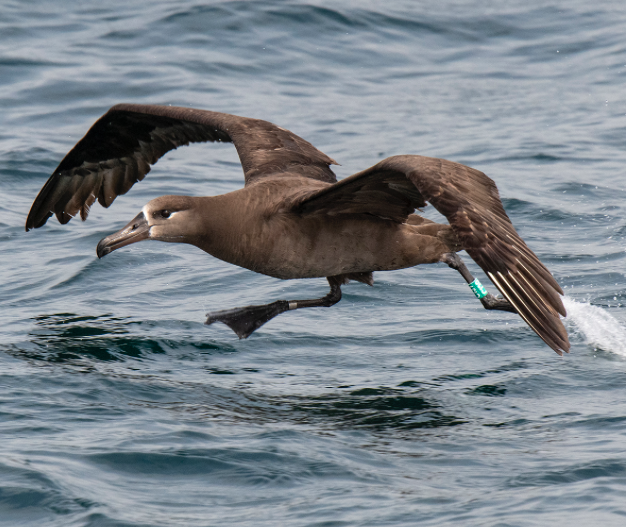During a whale watching trip on April 30, 2019 in Monterey Bay National Marine Sanctuary, Robert Schwemmer (West Coast Regional Maritime Heritage Coordinator of NOAA’s Office of National Marine Sanctuaries) observed a few Black-footed Albatross (Phoebastria nigripes) flying approximately 2 miles offshore of Watsonville. The Black-footed Albatross is fairly common offshore, particularly between February and July. And, it is the most frequently sighted albatross off the west coast of North America. However, one of the photographed albatross was unusual because it was wearing colored bracelets, or bird bands. The left leg had a green-colored band, and the right leg had a silver-colored band. Using the zoom lens on his camera, Schwemmer was able to read the numbers on the green band.

Bird banding data are useful in both scientific research and management and conservation projects. Individual identification of birds makes possible studies of dispersal and migration, behavior and social structure, life-span and survival rate, reproductive success and population growth (see USGS link).
The Bird Banding Laboratory (BBL) is an integrated scientific program established in 1920 supporting the collection, archiving, management and dissemination of information from banded and marked birds in North America. This information is used to monitor the status and trends of resident and migratory bird populations. Because birds are good indicators of the health of the environment, the status and trends of bird populations are critical for identifying and understanding many ecological issues and for developing effective science, management and conservation practices.
Found or observed bird bands or tags can be reported online.
After submitting bird band information online, participants can request a Certificate of Appreciation, which includes a summary of where and when the bird was originally tagged.
The Black-footed Albatross observed by Schwemmer was originally banded May 30, 2002 (16 years, 11 months at liberty!) at Whale-Skate Island in the French Frigate Shoals, which is now part of the Papahānaumokuākea Marine National Monument. That is approximately 2,400 nautical miles away! At the time of banding the sex and age were undetermined, but it was noted the bird was too young to fly.
The Black-footed Albatross comes to land, 96% of them to the northwestern Hawaiian archipelago, for breeding purposes only. The rest of its life is spent on the open ocean. The breeding adults arrive at their nesting sites by the end of October, and incubate and brood their single chick on low, flat islets and atolls from November until February. The parents continue to feed their chicks from March until June. Parents routinely fly more than 2,300 miles from the Hawaiian Islands to the coast of California in search of food for their chick. They spend the non-breeding season in the North Pacific Ocean (30-60 degrees northern latitude). They mate for life and can live as long as 40 years. The longevity record for the Black-footed Albatross is 41 years.
For more information on the natural history of the Black-footed Albatross (Phoebastria nigripes), see the SIMoN Species Database.
A local research project tagging Black-footed Albatross occurs in Cordell Bank NMS.